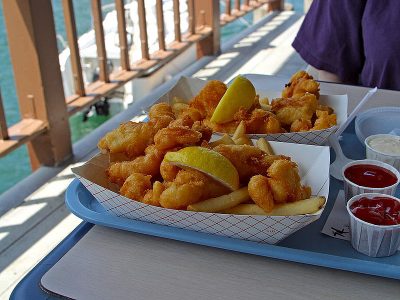
First of two parts.
The enduring appeal of fried fish is evident in its lifelong enthusiasts. Nick Wolosuk of Buxton Seafood, sells fish day after day on the Outer Banks, and his favorite fried fish is still his own recipe. And Andy Gaus has been working in the kitchen at Calabash Seafood Hut for 14 years, but still fires up his Fry Daddy at home on a regular basis.
Supporter Spotlight
Frying fish can seem deceptively simple. Take this recipe for Fried Drum from the Original Ocracoke Cook Book as an example: “Cut in pieces, salt and roll in corn meal; fry in hot oil ‘til brown.” That one sentence is the entirety of the preparation instruction. When it’s done right, you might think that’s all there is to it. But when it goes wrong, you wonder what happened. Even though there are few parts, each element – the breading, the oil, the fish, the cooking temperature – is important to the final outcome. Luckily, chats with a few North Carolina professionals are a good way to learn some secrets. Even if they tell you there’s not really that much to it, more questions and answers reveal there is often a specific process for their success.
In general, the rules are fresh fish, light breading, simple seasoning and hot oil.
Lard used to be the frying method of choice for fish. An 1872 Southern cookbook recommends cooking fish pieces in boiling lard. And that was how Stephen Holland learned, as well, when he dated the daughter of the owner of Faircloth’s, the classic seafood house in Wrightsville Beach. “I always had to wait for her to finish work, so her dad told me I might as well learn to cook while I was there,” he said.
After that start, he became the owner of Holland’s Shelter Creek Fish Camp restaurant in Burgaw, a remaining testament to the local popularity of fried seafood. “There aren’t many places like this left,” he said. He still serves thousands of pounds of fish, shrimp and oysters every week, with the help of people who have been with him many of the 34 years he’s run the restaurant that sits on the Northeast Cape Fear River. Holland has since moved from peanut oil to trans-fat-free soybean oil, because so many people are allergic to peanut oil, he said.

Lard is still a part of the recipe at some restaurants, though. Calabash, in the southern part of the state, is billed as the seafood capital of the world, serving up general portions of seafood in a laid-back atmosphere. Lundy’s Lard, a kind that is not hydrogenated, is part of the secret at Calabash Seafood Hut, said Gaus.
Supporter Spotlight
The Calabash style started to become well known more than 60 years ago. It’s one that’s emulated at restaurants throughout North Carolina and the South – and been lauded in publications such as The New York Times. The Calabash Seafood Hut, which was established in 1969, has a few other frying secrets, such as using self-rising flour, a simple salt and pepper seasoning and Carnation canned milk. What’s important, Gaus said — and the other cooks all agree — is the temperature. “You want to make sure it’s hot enough,” he said.
“I take my finger, coated with a little water, and test the oil,” said Wolosuk. “When its sizzles real good, you know it’s ready.”
The hot oil helps seal the fish so it cooks from steam and heat, and not oil saturation, which leads to soggy and unappetizing fish.
These professionals all use deep fryers as well. “There’s just more oil in it, so the fish is coated and completely covered,” said Norwood Frost of Frost Seafood House in Salter Path.
It allows for an evenly cooked fish. “I’ve been doing this for 35 years,” he said. “And I haven’t had many complaints.”
Frost also helps address the other issue in frying fish: the question on whether to use a wet dip, such as a mixture of egg and milk, when preparing the dish. Many cooks just rinse fish fillets, pat dry and then coat with a breader. Frost said that’s really all that’s necessary for most fried fish. “You might want to use a dip if you’re frying something like shrimp or scallops,” he said.
Of course, for those that like a thicker coating on fish, the wet dip before the breader is a good idea.
The quality of the fish, whether fresh or fresh frozen, is also more important to these cooks and chefs than the type of fish. Holland often pays specials attention to the paths the seafood industry takes, watching local flounder go to top buyers in Japan and noticing the increase of the price of oysters in the wake of the Gulf Coast oil spill. It all makes him especially careful of his sources, and the taste, of the fish he purchases. Wolosuk in Buxton relies on the seasonal catches to determine what fish end up on his plate. He likes drum and bluefish, and sometimes mahi mahi. There are many options here, just go for excellence, they say.

With good fish, you don’t want to overpower the delicate flavor with a lot of seasoning and spice. That’s why many of these cooks go for salt and pepper, and often little else. You can use many breaders, including cracker meal, but you might also want to look at breading mixes made in state. Wolosuk is a fan of Moss’ Seafood Breader Mix, from Buffaloe Milling Co. in Kittrell. Holland likes the products from Atkinson Milling Co., which was founded in 1757, in Selma. House Autry, based in Four Oaks, might be the most familiar to many fish-fry fans.
Keeping it simple doesn’t mean you can’t experiment. “You want something nice and mild,” Wolosuk said. “But believe it or not, a little paprika does wonders and gives it a really nice flavor.”
Others wouldn’t think of frying fish or seafood without a bit of Old Bay seasoning.
All of these cooks and chefs are quick to tout their credentials – usually in the form of how many hundreds of pounds of fish they fry each week and the number of years they’ve been doing it. So when you get your fresh flounder or spots, take their advice: keep it simple, but pay attention to the details.
Wednesday: Frying fish, step by step








